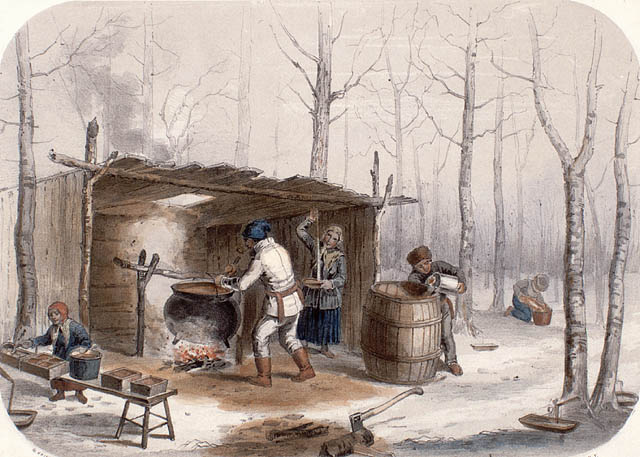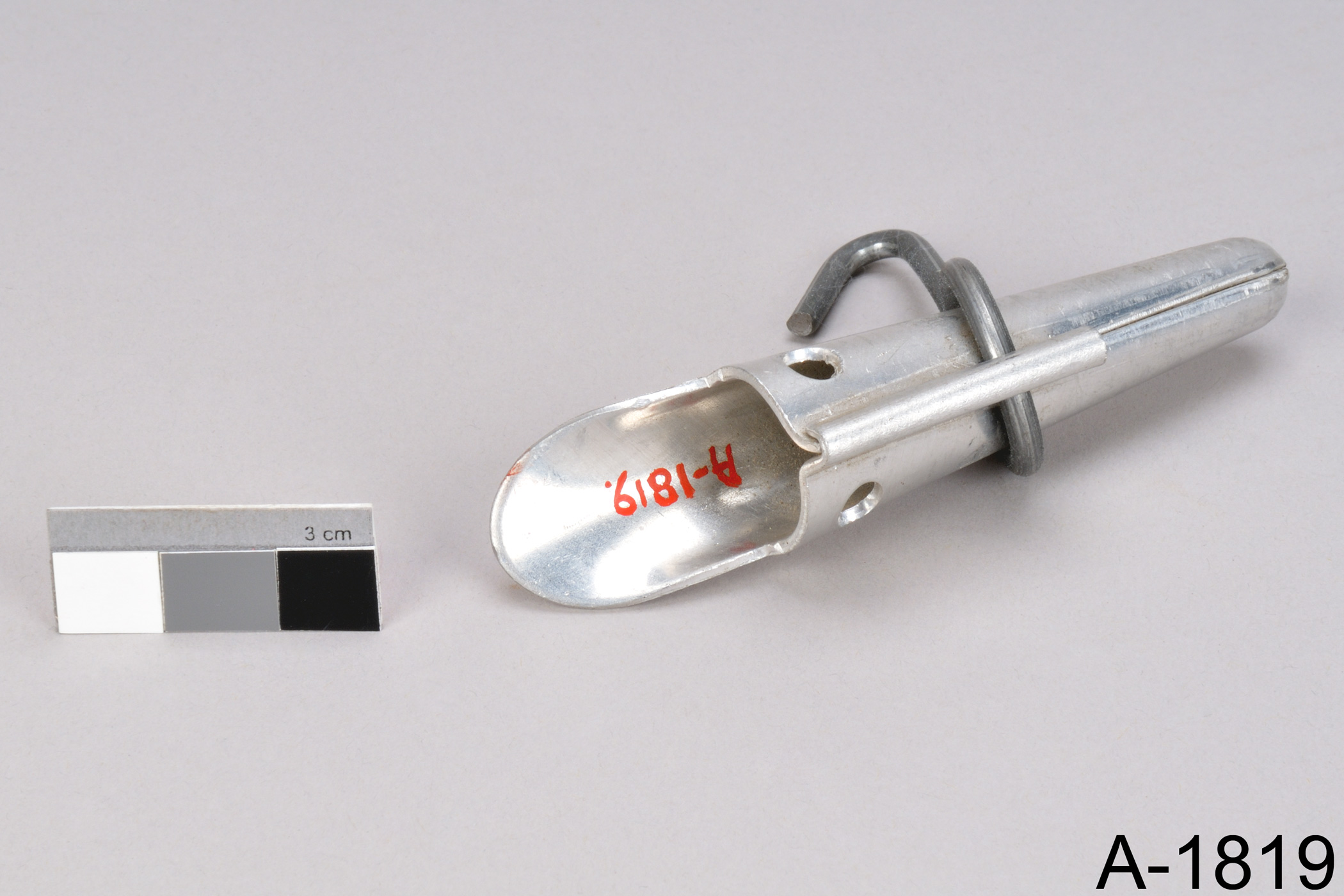Maple Sugar Mould
Artifact
Image
Video
Audio
 Activities
Activities
LOOK
Look closely at this object. What do you think its purpose is? Verify your answer by reading the Historical Context below.
THINK
Look at this object and read the Historical Context below. What questions do you have about this object, or the stories it represents? Share your questions with a partner.
Details
 Materials
Materials - Wood
Historical Context
Choose one of the three levels below to match your needs.
- This maple sugar mould was carved out of wood. Hot maple sugar poured into the mould would harden into heart shapes as it cooled.
- The mould is a piece of Quebec folk art. The heart pattern was very popular, but these moulds exist in many shapes and themes inspired by nature, religion or everyday life.
- Sugar maple trees are tapped in springtime to collect the sap that starts to run as the days warm up.
Scroll through the media carousel above to see a painting of people making maple sugar, an example of a birch bark container used to collect sap, and a metal sap spout from the Museum’s collection.
This maple sugar mould was carved out of wood. Hot maple sugar poured into the mould would harden into heart shapes as it cooled.
This decorative utensil is also an interesting piece of Quebec folk art: the personalized carved pattern would often identify the maker of the maple hearts. The heart pattern was very popular, but these moulds exist in many shapes and themes inspired by nature, religion or everyday life, reflecting the creativity of the carver.
Sugar maple trees are tapped in springtime to collect the sap that starts to run as the days warm up. Indigenous peoples of the Eastern Woodlands practised maple tapping long before the arrival of Europeans. Europeans learned this technique from Indigenous peoples.
Hot maple sugar would have been poured into this carved wooden mould, where it hardened into heart shapes as it cooled. Made of two pieces of wood held together with wooden pegs, the mould has two sets of three hearts, all pointing towards the centre. Each heart has a different motif carved into it.
This decorative form is also an interesting piece of Quebec folk art. The personalized carved pattern would often identify the maker of the maple hearts. The heart pattern was very popular, but these moulds exist in many shapes and themes inspired by nature, religion or everyday life, reflecting the creativity of the carver.
Sugar maple trees are tapped in springtime to collect the sap that starts to run as the days warm up. Indigenous peoples of the Eastern Woodlands practised maple tapping long before the arrival of Europeans. They made spiles (spouts) from hollowed elderberry or sumac branches, pushing these into the trees. As the sap began to drip, it was caught in birchbark baskets, then further processed by heating the sap.
Europeans learned this technique from Indigenous peoples, and started their own traditions of sap collecting and boiling to make syrup and sugar.
- This maple sugar mould was carved out of wood. Hot maple sugar poured into the mould would harden into heart shapes as it cooled.
- The mould is a piece of Quebec folk art. The heart pattern was very popular, but these moulds exist in many shapes and themes inspired by nature, religion or everyday life.
- Sugar maple trees are tapped in springtime to collect the sap that starts to run as the days warm up.
Scroll through the media carousel above to see a painting of people making maple sugar, an example of a birch bark container used to collect sap, and a metal sap spout from the Museum’s collection.
This maple sugar mould was carved out of wood. Hot maple sugar poured into the mould would harden into heart shapes as it cooled.
This decorative utensil is also an interesting piece of Quebec folk art: the personalized carved pattern would often identify the maker of the maple hearts. The heart pattern was very popular, but these moulds exist in many shapes and themes inspired by nature, religion or everyday life, reflecting the creativity of the carver.
Sugar maple trees are tapped in springtime to collect the sap that starts to run as the days warm up. Indigenous peoples of the Eastern Woodlands practised maple tapping long before the arrival of Europeans. Europeans learned this technique from Indigenous peoples.
Hot maple sugar would have been poured into this carved wooden mould, where it hardened into heart shapes as it cooled. Made of two pieces of wood held together with wooden pegs, the mould has two sets of three hearts, all pointing towards the centre. Each heart has a different motif carved into it.
This decorative form is also an interesting piece of Quebec folk art. The personalized carved pattern would often identify the maker of the maple hearts. The heart pattern was very popular, but these moulds exist in many shapes and themes inspired by nature, religion or everyday life, reflecting the creativity of the carver.
Sugar maple trees are tapped in springtime to collect the sap that starts to run as the days warm up. Indigenous peoples of the Eastern Woodlands practised maple tapping long before the arrival of Europeans. They made spiles (spouts) from hollowed elderberry or sumac branches, pushing these into the trees. As the sap began to drip, it was caught in birchbark baskets, then further processed by heating the sap.
Europeans learned this technique from Indigenous peoples, and started their own traditions of sap collecting and boiling to make syrup and sugar.
Summary
- This maple sugar mould was carved out of wood. Hot maple sugar poured into the mould would harden into heart shapes as it cooled.
- The mould is a piece of Quebec folk art. The heart pattern was very popular, but these moulds exist in many shapes and themes inspired by nature, religion or everyday life.
- Sugar maple trees are tapped in springtime to collect the sap that starts to run as the days warm up.
Scroll through the media carousel above to see a painting of people making maple sugar, an example of a birch bark container used to collect sap, and a metal sap spout from the Museum’s collection.
Essential
This maple sugar mould was carved out of wood. Hot maple sugar poured into the mould would harden into heart shapes as it cooled.
This decorative utensil is also an interesting piece of Quebec folk art: the personalized carved pattern would often identify the maker of the maple hearts. The heart pattern was very popular, but these moulds exist in many shapes and themes inspired by nature, religion or everyday life, reflecting the creativity of the carver.
Sugar maple trees are tapped in springtime to collect the sap that starts to run as the days warm up. Indigenous peoples of the Eastern Woodlands practised maple tapping long before the arrival of Europeans. Europeans learned this technique from Indigenous peoples.
In-Depth
Hot maple sugar would have been poured into this carved wooden mould, where it hardened into heart shapes as it cooled. Made of two pieces of wood held together with wooden pegs, the mould has two sets of three hearts, all pointing towards the centre. Each heart has a different motif carved into it.
This decorative form is also an interesting piece of Quebec folk art. The personalized carved pattern would often identify the maker of the maple hearts. The heart pattern was very popular, but these moulds exist in many shapes and themes inspired by nature, religion or everyday life, reflecting the creativity of the carver.
Sugar maple trees are tapped in springtime to collect the sap that starts to run as the days warm up. Indigenous peoples of the Eastern Woodlands practised maple tapping long before the arrival of Europeans. They made spiles (spouts) from hollowed elderberry or sumac branches, pushing these into the trees. As the sap began to drip, it was caught in birchbark baskets, then further processed by heating the sap.
Europeans learned this technique from Indigenous peoples, and started their own traditions of sap collecting and boiling to make syrup and sugar.




